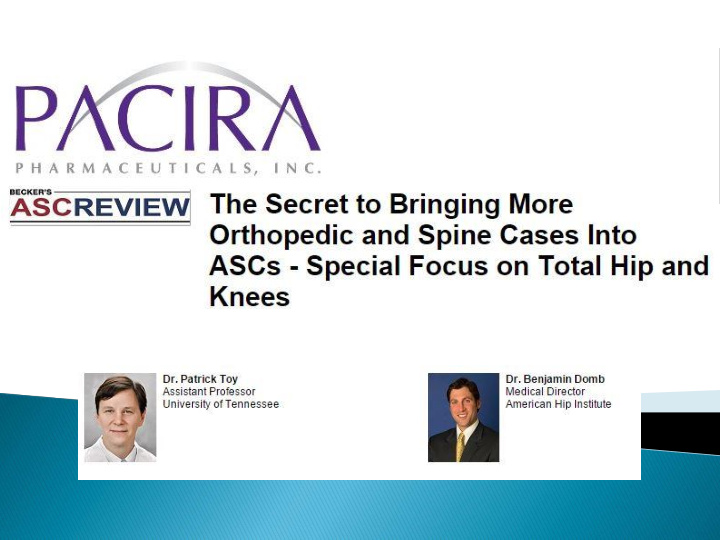



Inpatient Hospital Hospital Hospital Inpatient Surgery Day 1 Day 2 Day 3 Rehab 23 hour or Outpatie atient nt ASC outpatient Rehab
Patients don’t need prolonged hospitalization ◦ More functional ◦ Pain control ◦ Blood management Patient centered approach Cost effective
Organization Patient selection Preparation Execution
ASC director Insurance issues Materials management/Vendors PACU/23 hour stay Rehabilitation
Appropriate total joint candidate Insurance Medical clearance Communication and Education Motivated to improve Important decision in the early cases performed at ASC
Patient education is paramount! Prehab Medical staff education ◦ Anesthesia ◦ Nurses ◦ Surgical staff ◦ Therapist
Instruments ◦ Sterilization ◦ Multiple sets ◦ Power equipment ◦ Bed set-up ◦ Fluoroscopy Implants
Pain management ◦ Preoperative ◦ Intraoperative ◦ Postoperative Home equipment Rehab
Hospital back-up plans
Simulate first Team approach ◦ Anesthesia ◦ Nurses ◦ Therapists ◦ Surgeon ◦ Surgical staff
Dr. Domb ◦ Performs Hip Arthroscopy and THA at ASC ◦ Two techniques Traditional MAKO robotic-assisted technology
Patient Selection! ◦ Assessment of pain prior to procedure ◦ Evaluation of comorbid conditions and current health status ◦ Insurance pre- approval process ◦ Research evaluating clinical outcomes
Hip Arthroscopy: What is Treatable Today?
Labral tears Femoro-acetabular impingement (FAI) Instability Borderline Dysplasia Gluteus Medius Tears Snapping Hip
Labral Base Refixation in the Hip: Rationale and Technique for an Anatomic Approach to Labral Repair Robert Fry, M.D. Benjamin Domb, M.D.
Labral l Base e St Stit itch Simple Stitch • Labrum everted + bunched 1. Triangular shape preserved • No contact with femoral 2. Restore transitional zone head 3. Restore suction seal • No suction seal
Domb, Giordano, Philippon Arthroscopy 2013
Tendon Trochant er Large Full Thickness Tear Double-Row Suture-Bridge Repair
• 3D virtual pre-op implant planning • Navigated stem placement • Haptically guided acetabular preparation & placement • Combined Version • Hip Length • Hip Offset
More accurate positioning of implants with: • Robotic arm guidance • 3-D visual feedback • Real-time data Decreased likelihood of mechanical failure Improved outcomes
1 . Plan & Broach 2 . Combined Anteversion 3. Pre-operative 4 . Robotic Cup Femoral Stem Assessment Cup Planning Placement (scree creen shot – femur/ r/tibia) ibia) 5. Quantified Surgical Report 37 ° 2 1 m
Inputs: ◦ Patient CT Scan ◦ 3D Bone Models ◦ Size of Implant ◦ Center of Rotation ◦ Inclination ◦ Version ◦ Native Femoral Version
Inputs: → 3D Templating → Neck length is selected based on patient anatomy Outputs: ← Planned neck resection plane ← Complete visualization of the planned implant positions ← Measurement of final broach position
• Femoral version is difficult to control in a cementless, broach- only, system • Therefore, the planned cup version is updated intra- operatively based on the femoral version achieved during broaching (Dorr, CORR 2009) (Jolles, JoA 2002)
Software Provides: ← Complete visualization of the planned implant positions ← Predicted hip length ← Predicted offset
1 . Visual Feedback : Green/White/Red 2. Tactile Feedback : Haptic Stiffness (0.5-1mm) 3. Audible Feedback : Beeping (0.5-1mm) Resected bone 0.5mm 1mm
• Robot haptically guides both reaming & impaction • Real-time numeric & graphical representation of the progression of reaming & impaction
Conical Haptic Line Haptic • Initial Reaming • Reaming, Impaction
Continued assessment of THA outcomes based on: ◦ Component placement ◦ Leg length discrepancy ◦ Global offset ◦ Predictive vs actual positioning ◦ Comparative studies or various approaches Published articles in: ◦ CORR ◦ Journal of Arthroplasty ◦ Orthopedics
Analgesia in THA involves multimodal analgesia Postoperative opioid- related events can slow recovery and increase patients ’ length of stay Long-acting local anesthetics can reduce early postoperative pain at the surgical site
Decreasing opioid use while maintaining adequate pain control could reduce: ◦ opioid-related events ◦ increase patient time to first ambulation ◦ decrease length of stay
Research comparing the effectiveness of liposomal bupivacaine with bupivacaine following total hip arthroplasty. Study group= 27 consecutive patients who received liposomal bupivacaine Control group=previous 30 consecutive patients who received bupivacaine alone ◦ All patients received a combination of celecoxib 400 mg PO, pregabalin 75 mg PO and 1gm of IV acetaminophen prior to procedure ◦ The study group received 20 cc of liposomal bupivacaine, combined with 40 cc 0.25% bupivacaine HCl with epinephrine and 20 cc of preservative free normal saline ◦ The control group received 60 ml of 0.25% bupivacaine HCl with epinephrine
The study group median length of stay was 1.9 days; the control group median length of stay was 2.5 days (p = 0.05). Both groups had average VAS scores of 2.8 during the first 24 hours after surgery and 3.3 during the time frame of 24 to 48 hours after surgery The study group average morphine equivalent use during the first 24 hours after surgery was 24.0 mg, and the control group 53.4 mg (p <0.05) From 24 to 48 hours from surgery, the average morphine equivalent use in the study group was 41.1 mg, and the control group 64.9 mg,
Liposomal bupivacaine administration during THA appears: ◦ to decrease the need for opioid use post operatively ◦ to decrease length of stay The results of this study justify the need for a well-designed RCT utilizing liposomal bupivacaine as part of multimodal analgesia during THA ◦ RCT started September 2014 ◦ 11 patients enrolled to date
Patient preparation Simulation in hospital Staff preparation Team approach Good experiences will generate more opportunities
Questions?
Recommend
More recommend